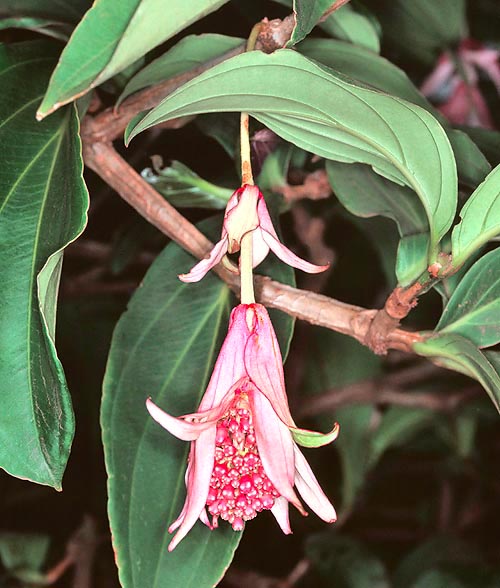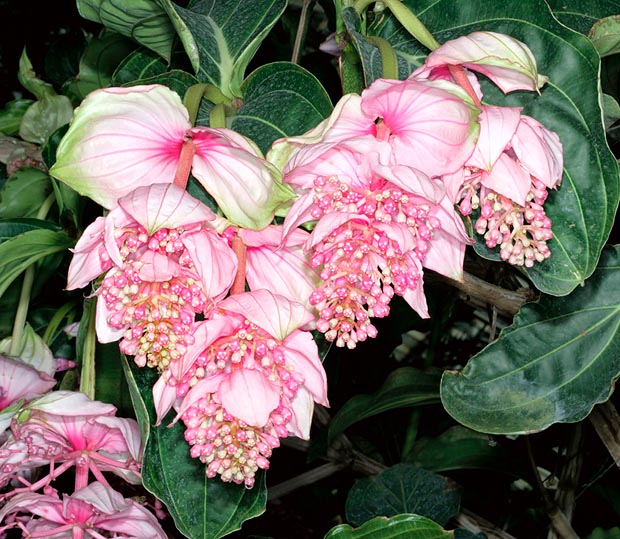Family : Melastomataceae

Text © Pietro Puccio

English translation by Mario Beltramini

Medinilla magnifica is an even 2 m tall epiphytic shrub © Giuseppe Mazza
The genus is honoured to José de Medinilla y Pineda, governor of the Marianas during the first decades of the XIX century; the name of the species is the Latin word “magnifica” = magnificent, splendid, with obvious reference.
Common names: kapa-kapa (Philippines); chandelier bush, chandelier tree, jungle chandelier, Malaysian orchid, pink lantern, rose grape, showy medinilla (English); médinilla magnifique (French); medinila, uva-rosa (Portuguese); medinila (Spanish); Medinille (German).
The Medinilla magnifica Lindl. (1850) is an evergreen shrub, up to 2 m tall with woody branches with an almost quadrangular section and tufts of rigid and caducous bristles, 1 cm long at the nodes; it grows as epiphyte on the trees, sinking the roots into the vegetal debris which accumulate in the hollows, or on the ground in the glades.
The leaves are opposite, sessile (without petiole), of a glossy dark green colour, coriaceous, oblong-obovate, up to 35 cm long and 25 cm broad, with sharp apex and conspicuous whitish nervations. The inflorescences are in hanging terminal racemes much ramified, up to 45 cm long, with great deciduous pink bracts, four per each node, from 3 to 10 cm long; the flowers, of 2 cm of diameter and 4 cm of length, which open successively for about two months, have an intense pink colour with 5 petals and ten yellow stamina.
The fruits are globular purple berries of about 6 mm of diameter, containing tiny seeds. It easily reproduces y seed, to be placed on the surface of the substratum, or simple sphagnum, kept humid, and by cutting in confined atmosphere, at the temperature of 24-26 °C. The specific name of this plant is quite appropriate seen its spectacular flowering and the huge glossy leaves, cultivable in the tropical zones and, marginally, in the humid subtropical ones in filtered or partly shaded sunlight and out of the wind, with lowest temperatures which should never be less than 10 °C.
The ambient temperature must be always high and the watering must be frequent during the vegetative period, reduced in winter, but never letting the substratum to be completely dry; the same must be porous, light, rich of organic substance and with addition of siliceous sand, by around the 30%, for improving the drainage, as the plant is particularly sensitive to stagnations.

The inflorescences are even 45 cm long hanging racemes, with huge deciduous pink bracts © Giuseppe Mazza
It is to be placed in a location where it may get the most possible luminosity, also some hours of direct sun in the morning, with a substratum as before told.
The best temperature must be high (24-28 °C), only for a short period in winter the temperature must get down to 16-18 °C and the substratum is to be left to partly dry up in order to stimulate the flowering.
When this event begins, the temperature and the watering are to be increased.
The ambient humidity is crucial and must be as high as possible; for increasing it, in addition to the system of the large saucer filled up with gravel or expanded clay constantly wet where to lay the pot, daily nebulisations are to be done with lime-free water at ambient temperature.
The watering must be regular from spring to autumn, keeping constantly humid, but not soaked the substratum; reduced in winter, during the resting period, in such a way to allow only the superficial layer to dry up, but keeping always a high ambient humidity.
The fertilizations with water-soluble products are useful, provided with a high content of phosphorus (type 10-20-10), at half dose of what suggested, every two, three weeks, but during the quiescence period. Considering the weight of the inflorescences, it may be necessary to prepare a proper support. The possible prunings, in order to contain its size, must be done after the blooming.
→ To appreciate the biodiversity within MELASTOMATACEAE family please click here.
